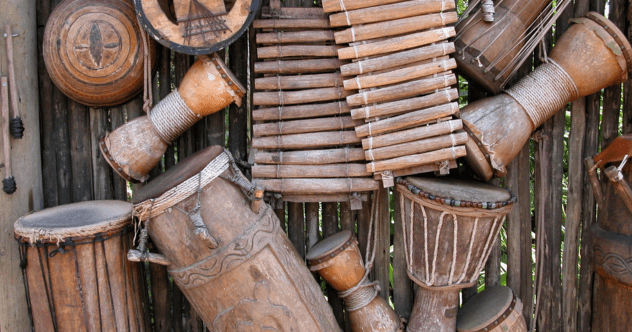Music is a universal language, connecting people all over the world. While we often think of guitars, pianos, and drums, there are many unique musical instruments that add color and diversity to the world of sound. Let’s explore ten musical instruments that might just pique your curiosity and captivate your ears.
10. Hydraulophone: Harmonizing with Water’s Flow
The hydraulophone is a marvel. Imagine a keyboard that uses water instead of electricity or air to make sound. It’s like Poseidon’s instrument of choice!
How does it work? The hydraulophone has a series of water jets coming out of a metal tube. When you cover a jet with your finger, it changes the water flow and creates different pitches and tones. It’s like playing a keyboard, but with water. Quite a splash, right?
Steve Mann created the hydraulophone in the late 20th century. Since then, it’s become popular in parks, museums, and music circles. It also offers a tactile experience. Feeling the vibrations as you play adds another dimension to the music.
If you ever see peculiar water jets in a park, give the hydraulophone a try. You might just unleash your inner maestro and impress onlookers with your aquatic melodies.
9. Theremin: Unleashing the Magic of Electromagnetic Waves
Imagine making music without even touching an instrument. With the theremin, it’s possible. Stand in front of it, and your hands conjure ethereal melodies from thin air.
Léon Theremin, a Russian inventor, created it in the early 1920s, and the world was fascinated. The theremin uses capacitance and electromagnetic fields. By moving your hands near its antennas, you disrupt these fields, creating haunting sounds.
Mastering the theremin is like taming a musical ghost. It needs finesse, patience, and a bit of magic. Your hands become conductors, delicately dancing to produce pitch and volume. It’s like a ballet, but with ghostly melodies instead of pirouettes.
One wrong move might summon a forgotten symphony. But get it right, and you’ll captivate audiences with its eerie charm. From classical pieces to sci-fi soundtracks, the theremin has left its mark, becoming one of the most unique instruments.
8. Yaybahar: A Fusion of Acoustic and Electronic Innovation
Let me introduce you to the yaybahar. It’s like a string instrument and a sci-fi sound machine had a baby. You won’t believe your ears when you hear it sing.
The yaybahar isn’t your usual instrument. It looks like something from a steampunk fantasy. Imagine a metal frame with strings attached to drums and resonators, plus some springs and other odd bits. That’s the yaybahar.
When you pluck the strings or stroke the surfaces, the vibrations travel through the frame. This creates an unearthly melody that’ll send shivers down your spine. It sounds like music from another dimension. Görkem Şen, the inventor, deserves praise for creating such a marvel, exploring the connection between sound and vibration.
7. Marble Machine: Engineering Marvel and Musical Wonder
What happens when you combine mechanics, engineering, and music? You get the Marble Machine—a device that turns marbles into melodies. Martin Molin, a Swedish musician, created this marvel of engineering and artistry.
At first glance, the Marble Machine looks like a jumble of gears, levers, and tubes. But it’s much more. Its design turns the simple act of dropping marbles onto different instruments into a symphony. Each marble seems to have its own musical destiny, dancing through xylophones, drums, and cymbals.
Molin crafted this instrument to be entertaining. Watching the Marble Machine is like seeing a mini orchestra conducted by gravity.
The fun doesn’t stop there. Molin’s creation is a visual spectacle, too. With its wooden framework and vibrant colors, the Marble Machine is a work of art. It’s like something from a fairy tale, where music and magic come together.
6. Crwth: An Ancient Welsh Treasure
The crwth—pronounced “krooth”—is like a medieval string instrument brought to the 21st century. This odd instrument looks like a mix of a violin and a harp, but it’s neither.
The crwth is a wooden box with a bowed neck. What sets it apart? It’s Welsh, through and through, hailing from Wales. In fact, it’s one of the oldest known string instruments in Europe, dating back to the Middle Ages.
Unlike the four strings of a violin, the crwth has six strings, played with a bow. You finger the strings with one hand while bowing with the other. It’s like patting your head and rubbing your belly at the same time—a fun challenge for musical adventurers.
5. Toha: Harnessing Nature’s Ancient Rhythms
Our next musical discovery takes us to the toha, also known as the totem harp. It’s a blend of nature and music, like something from a fairy tale.
The toha looks like it’s been plucked from a mystical forest. It’s a vertical harp, with strings stretched between a wooden frame. The frame resembles a totem pole with intricate carvings, making a statement on stage.
The toha taps into nature’s ancient rhythms. The design resonates with the earthy vibes of the wilderness. Each strum feels like communing with the spirits of the forest.
The sound is pure magic. Imagine the rustle of leaves and the whisper of wind, woven into a melody that transports you to another realm. It’s hauntingly beautiful and strangely comforting.
4. Glass Armonica: Benjamin Franklin’s Musical Magic
Meet the glass armonica, a musical spectacle where Mozart meets a crystal-clear symphony. Imagine playing music on wine glasses with 18th-century elegance and Benjamin Franklin’s genius. That’s the glass armonica.
Created in 1761 by Benjamin Franklin, this instrument looks like glass bowls arranged by size and filled with water. Franklin mounted glass bowls on a spindle and rubbed their rims with wet fingers. The result? A haunting melody that rivaled orchestras.
Why glass? Franklin knew that the resonance and tones from glass friction were unique. The glass armonica was loved by composers like Beethoven, and even Marie Antoinette. Its sounds were thought to have healing properties, placing it in concert halls and apothecaries.
3. Cimbalom: Trapezoidal Charms
Meet the cimbalom, a quirky instrument that’s about to charm its way into your musical heart. Imagine a wooden trapezoid with strings, played with mallets. This Hungarian delight is a feast for the ears and a visual spectacle.
With roots in the 19th century, the cimbalom has a rich history, charming its way through Eastern European folk music and classical pieces. It’s the child of a piano and a hammered dulcimer, creating a unique sound.
The cimbalom’s strings are struck, producing tones that can be a lullaby or a lively dance. It’s the secret ingredient in many Hungarian and Romanian tunes, giving them a flavor that’s hard to replicate.
Don’t be fooled by its roots—the cimbalom is coming back in contemporary music, adding eccentricity to modern compositions. Its percussive and melodic nature makes it a choice for musicians who want to break from the ordinary.
2. Otamatone: Quirky Charm and Playful Melodies
The Otamatone is a delightful oddity. Picture a mix of a synthesizer and a cute alien tadpole. It’s as if E.T. joined a jazz band.
What is the Otamatone? It’s a musical note in a wacky, squeezable creature with a mouth and a musical scale on its neck. Pressing its neck and squeezing its body makes different pitches, sounding like a theremin and a cartoonish voice.
This little guy is from Japan, which isn’t surprising. It quickly gained popularity for its uniqueness and charm.
Mastering the Otamatone might not get you into Carnegie Hall, but who cares when you’re having fun? Grab your Otamatone, embrace the whimsy, and let the music flow. Maybe your rendition of “Twinkle Twinkle Little Star” will go viral.
1. Hurdy-Gurdy: Medieval Marvel with a Modern Twist
Have you heard of an instrument that sounds like a medieval time machine? Let me introduce you to the hurdy-gurdy—a mix between a violin and a hand-cranked organ grinder. This instrument dates back to the 11th century.
Imagine a wooden box with strings, a hand-crank like a vintage coffee grinder, and keys that belong on a pirate’s treasure chest. The magic happens when you turn the crank, making a wheel rub against the strings, producing a lovely sound.
Don’t let the odd look fool you—the hurdy-gurdy has serious musical chops. Its tones can take you to a medieval castle or a Renaissance fair. And it’s fun to watch someone crank and finger it at the same time.
The next time you want a musical adventure, give the hurdy-gurdy a spin. It’s not an everyday instrument, but that’s what makes it a hidden gem.










